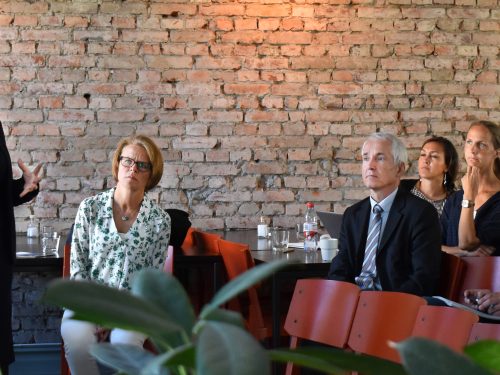Modelling electricity in environmental footprints
Summary
The European Commission developed a framework for life cycle assessment (LCA) denoted Product Environmental Footprint (PEF) in collaboration with representatives from the EU Member States, industry, and researchers. The PEF framework is now being used in a Regulation for photovoltaics (PV) within the Ecodesign Directive. It may become a precedent for future use of PEF in a policy context.
The PEF Guidance and the draft PV Regulation both state that production of electricity should be modelled using as specific information as possible. Input data on a specific technology or supplier should be used in the calculations when contractual instruments give a valid basis for this. The calculation rules include a description of what is required from a valid contractual instrument. When no such instrument is in place, the rules stipulate that the electricity supply should be modelled using data on the residual consumption mix in the country.
However, the calculation rules in the draft PV Regulation are not based on the latest version of the general PEF methodology. Concern has also been raised that the use of contractual instruments such as Guarantees of Origin entail a risk for greenwashing that can put European PV producers at a disadvantage. The general PEF methodology is in addition interpreted and applied in diverging ways by different actors and countries. The PEF rule to use a national residual mix is, for example, in Sweden interpreted to refer to a Nordic or Scandinavian residual mix, while other countries follow this rule to the letter.
This project aims to investigate the need for revised methods and revised text on the modelling of electricity supply in PEF as given by the general PEF guidelines and in the draft PV Regulation. We also aim to present tentative suggestions for amended text, when revisions are called for. The project involves a literature study that includes PEF documents and several other frameworks for LCA and carbon footprint. We also interviewed representatives from the Swedish Energy Agency and the Swedish Environmental Protection Agency, researchers at institutes and industry with experience from applying the PEF methodology, and representatives from relevant governing bodies. The outcome from literature studies and interviews was analyzed and forms the basis for our suggestions for amendments in the method and text.
Our interviews and analysis confirm that key concepts such as contractual instruments, Guarantees of Origin, tracking and tracking systems, residual mix, etc. are not fully defined or sufficiently explained. This makes it difficult for PEF practitioners to apply the method. It also invites subjective choices into the interpretation and application of the PEF rules.
Several of our interviewees share the concern that Guarantees of Origin and similar instruments indicate that the electricity is renewable even when there is no increase in renewable electricity production. This gives companies an incentive to buy Guarantees of Origin rather than investing in electricity efficiency.
We also find that the use of national residual data overestimates the significance of national borders between countries with interconnected electricity grids, particularly if the countries form a common electricity market. Electricity users in a country with a good residual mix get little incentive to invest in energy efficiency, even when a reduced electricity consumption means that more electricity can be exported to a country where the domestic electricity production has a poor environmental performance.
The principles in the current PEF approach for modelling electricity fits in the context of attributional LCA. It also corresponds to how the production of other goods is typically modelled in LCA. However, to make PEF results accurately indicate what actions and decisions reduce climate and environmental impacts, it would be better to choose a different approach for modelling the electricity supply. Elements that can be used in such an approach can be found in other existing frameworks. Ideally the electricity supply should be modelled using marginal data, i.e., data that reflect how a small change in the electricity demand affects the electricity production. However, marginal data depend strongly on the method and model used for identifying marginal impacts on the electricity supply. To avoid making PEF calculations highly subjective, the rules should include a specific method to identify the marginal electricity supply. Here, the method used by the Ecoinvent team is an interesting option: each unconstrained technology is part of the marginal mix in a country to the extent that it contributes to the projected future increase in electricity production.
Less accurate but still reasonable results would probably be obtained if electricity supply is modelled using average data for the electricity market where the electricity is used. To acknowledge that electricity users can contribute to increased production of renewable or fossil-free electricity production, exemptions from the rule to use average data should be made when:
- the electricity is produced at the site where it is used, and contractual instruments are not sold to a third party,
- the electricity is produced in a directly connected power plant, if this power plant was built after or at the same time as the production plant where the electricity is used, and contractual instruments are not sold to a third party,
- the electricity user built or had a power plant built elsewhere after or at the same time as the production plant where the electricity is used, and contractual instruments are not sold to a third party,
- the electricity user enters a long-term power purchase agreement that enables investment in new electricity-production capacity that would not otherwise have been viable, or
- the electricity is used only when the price is low enough to indicate that wind, hydro, solar, or nuclear power supplies the marginal electricity.
If the existing PEF approach based on contractual instruments and tracking systems is retained, the rule to always use data on supplier-specific electricity products in countries with a 100% tracking system should still be removed. Data on specific electricity-production technologies cannot be used when the electricity supply to a specific process is unknown, even if the country has a 100% tracking system.
To reflect the most recent version of the general PEF rules, the PV Regulation should allow for the use of data reflecting the residual mix of a region (e.g., EU+EFTA) as a last option.
The Swedish use of Scandinavian residual data instead of Swedish residual data should also be changed, since the use of national residual data is explicitly stipulated in the PEF rules. It is difficult to defend a contradiction to this rule, since Sweden stands alone in this position: national data are used in other Scandinavian countries.
The current PEF rules would also benefit from clarifications on how to interpret and apply the rules. We present several suggestions for clarifications in the text.
Regardless of which approach is selected for modelling electricity in future PEFs, the feasibility and robustness of the method would benefit from a database with electricity data. Hence, we recommend that such a dataset is developed, published, and regularly updated. The content of this task depends on the approach used for modelling electricity:
- If electricity production is modelled using marginal data developed through the Ecoinvent approach, data on 40 countries already exist in the Ecoinvent database. Marginal data for other countries need to be developed from existing or new generated plans or projections on the future electricity production.
- The essentially location-based approach recommended in this report would require a significant effort to identify to what extent different countries and price areas form common markets. The average data for each country and electricity-price area would then be calculated based on the results of this investigation.
- If the current, market-based approach remains, a major task is to check the validity of tracking systems in countries outside Europe. Such an assessment, which requires both legal and language expertise, would help deciding whether to calculate and publish residual or average data for each country.
In a possible second stage of the project, we hope to discuss these suggested changes with actors and other stakeholders in Sweden and other Nordic countries to refine the proposals and investigate to what extent we can reach consensus on them.


